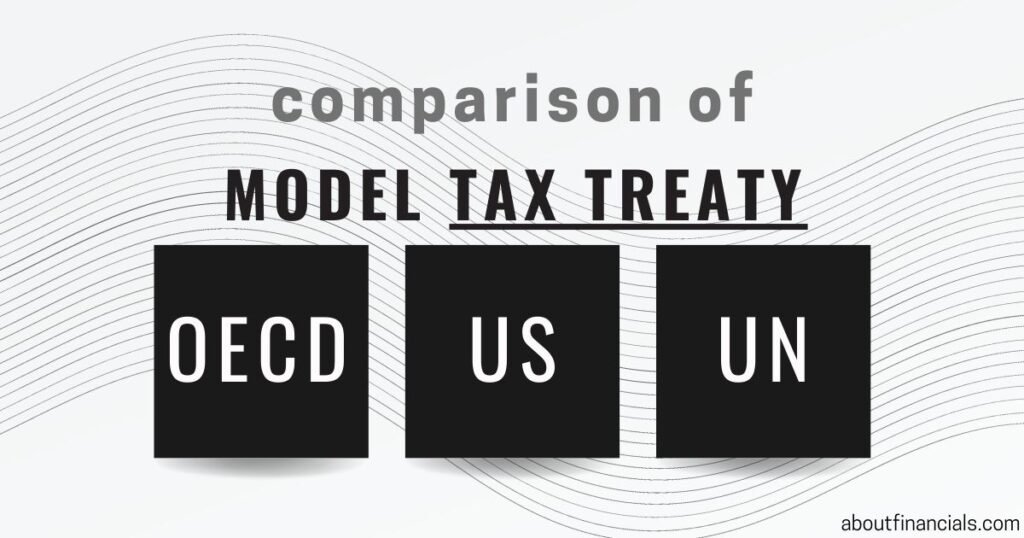In this article, we delve into the details of three influential tax treaty models: the OECD Model Tax Treaty, the US Model Tax Treaty, and the UN Model Tax Treaty.
These models lay the groundwork for cross-border tax cooperation, addressing critical aspects such as Permanent Establishment, Dividends, Interest, Royalties, Capital Gains, Limitation on Benefits, and Mutual Agreement Procedure. So, let’s embark on this enlightening journey and uncover the nuances that shape the world of international taxation!
Comparison of OECD vs US vs UN model tax treaties

Permanent Establishment:
OECD Model: Article 5 of the OECD Model Tax Treaty provides a comprehensive definition of Permanent Establishment (PE). It covers various types of fixed places of business, including construction sites, service PEs, and agency PEs.
US Model: The US Model Tax Treaty aligns closely with the OECD Model regarding Permanent Establishment. However, it has a shorter duration requirement for construction sites (6 months) compared to the OECD Model (12 months).
UN Model: The UN Model Tax Treaty also includes a definition of Permanent Establishment, which generally aligns with the OECD definition. However, it does not have a specific provision for construction sites.
Dividends, Interest, and Royalties:
OECD Model: The OECD Model allows for source-state taxation of dividends, interest, and royalties, often at reduced rates. It includes certain conditions and exceptions for taxation.
US Model: The US Model generally eliminates source-state taxation of dividends, interest, and royalties between related persons, favoring residence-state taxation instead.
UN Model: The UN Model generally allows for source-state taxation of dividends, interest, and royalties. However, it provides for reduced rates or exemptions in specific circumstances to promote cross-border investment and development.
Capital Gains
OECD Model: The OECD Model grants the source country the right to tax capital gains derived by a resident of one Contracting State from the alienation of immovable property located in the other Contracting State.
US Model: The US Model includes a provision similar to the OECD Model but goes a step further. The US Model explicitly includes gains from movable property that forms part of the business property of a permanent establishment or pertains to a fixed base.
UN Model: The UN Model generally grants the source country the right to tax capital gains derived from the alienation of immovable property located in that country. However, it does not explicitly address the taxation of gains from movable property.
Limitation on Benefits (LOB) Provision:
OECD Model: The OECD Model does not have a specific LOB provision. It relies on domestic anti-abuse rules and the main purpose test included in the preamble to prevent treaty-shopping.
US Model: The US Model includes a detailed LOB provision that sets out various tests to determine if treaty benefits apply. The intention is to prevent improper use of the treaty through treaty-shopping.
UN Model: The UN Model does not include a specific LOB provision. However, it includes a more general anti-abuse provision that allows countries to deny treaty benefits in cases of abuse or improper use of the treaty.
Mutual Agreement Procedure (MAP):
OECD Model: Article 25 of the OECD Model Tax Treaty allows taxpayers to present a case to the competent authority of either Contracting State for the resolution of disputes and double taxation issues.
US Model: The US Model Tax Treaty includes a similar MAP provision, which enables taxpayers to present cases to the competent authority. It also explicitly allows for arbitration if the competent authorities cannot reach an agreement within a certain time. This mechanism provides an additional avenue for resolving disputes efficiently and fairly.
UN Model: The UN Model includes a MAP provision that allows taxpayers to present cases to the competent authority of either Contracting State. It encourages the competent authorities to resolve disputes through mutual agreement but does not explicitly mention arbitration.
Final words
By understanding the provisions of these three prominent tax treaty models, you gain valuable insights into the framework that governs international taxation. These models serve as blueprints for countries to establish bilateral tax agreements, fostering fair and transparent tax practices in the global arena.
After reading the above comparison of key concepts, we believe that you are better equipped to navigate the complexities of international tax treaties and make informed decisions in the realm of cross-border activities. So, keep exploring, stay curious, and let the world of international taxation unfold before you!
